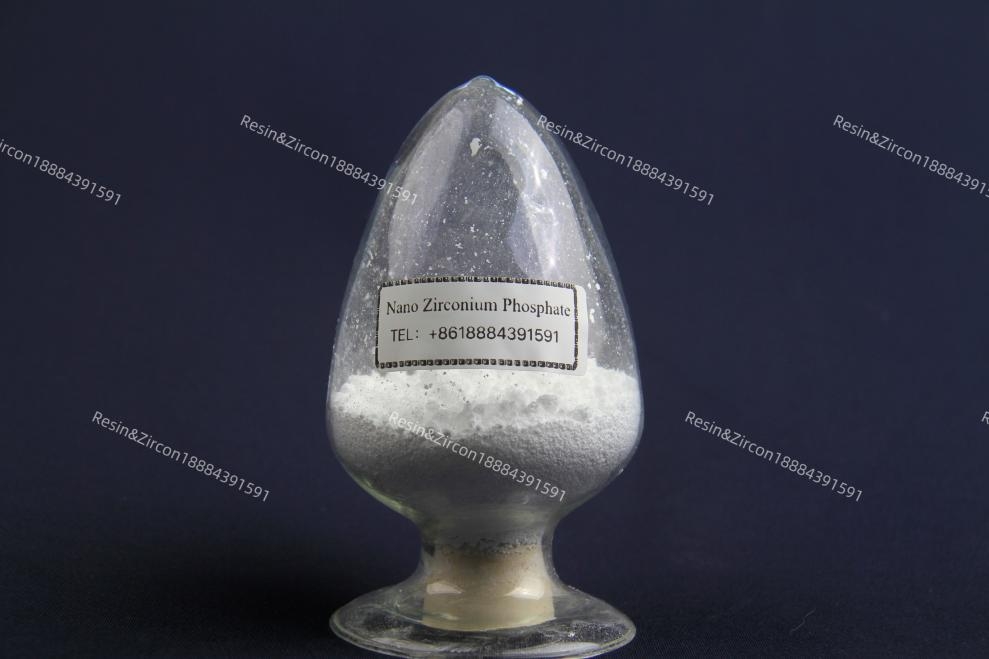Nano Zirconium Phosphate
Nano-zirconium phosphate (NZP) is a nanoscale inorganic material with layered or porous structure. Due to its excellent thermal stability, chemical inertness, ion exchange capacity and large specific surface area (nanometer effect), it is widely used in material modification, environmental protection, catalysis and biomedicine.

Application area
1. Plastic/rubber modification: improve the heat resistance (such as PVC, polypropylene heat deflection temperature), flame retardancy, mechanical properties (tensile strength, impact strength) and anti-aging.
2. Coating: enhance corrosion resistance (barrier to water and oxygen permeation), wear resistance, high temperature resistance (such as high temperature anticorrosive coating), and give antibacterial and self-cleaning functions (through the loading of silver ions).
3. Ceramics/glass: improve sintering performance, reduce sintering temperature, improve the density and mechanical strength of ceramics (e.g., alumina ceramics).
4. Heavy metal removal: adsorbs Pb²+, Cd²+, Cr⁶+, As³+ and other heavy metal ions in water (especially strong affinity for high valence metal ions).
5. Organic pollutant adsorption: adsorbing dyes (such as methyl orange, rhodamine B), phenols, antibiotics, etc., through hydrophobic interaction or hydrogen bonding.
6. Water softening: remove hardness ions such as Ca²⁺ and Mg²⁺ in water to reduce water hardness.
7. Catalysis: the supported metal (e.g., Pd, Pt) is used for organic synthesis catalysis (e.g., hydrogenation reaction), and the layered structure can improve the dispersion of active components
8. Drug carrier: the interlayer structure can be used to encapsulate drugs (such as antibiotics and anticancer drugs), which can be slowly released through pH or ion stimulation to improve the sustained efficacy.
9. Antibacterial materials: after loading silver ion (Ag⁺), long-term antibacterial can be achieved through the slow release of Ag⁺ (such as medical dressings, oral materials).
10. Bone repair materials: good compatibility with hydroxyapatite (the main component of bone) can enhance the mechanical properties and bioactivity of repair materials.
Product features:
1. Material modification mechanism: barrier and enhancement (to hinder the transfer of heat, gas and liquid), improve flame retardant and anticorrosive properties.
2. Adsorption mechanism: ion exchange and surface adsorption.
3. Catalytic mechanism: The carrier plays a role to avoid agglomeration and improve the dispersion. Acid catalysis reduces the activation energy of the reaction.
4. Mechanism of bio-medicine: drug release and antibacterial mechanism.
Use cases:
The recommended amount depends on the use scenario
1. Material modification:
1.1 Plastic/rubber: It is recommended to add 0.5-5 wt% (based on the mass of the matrix)
1.2 Paint/coating: The recommended addition is 0.1-3 wt%
1.3 Ceramics: The addition amount is 1-10 wt%
2. Water treatment:
2.1 Adsorption of heavy metal pollutants: The recommended dosage is 0.1-5 g/L
2.2 Water softening: The recommended dosage is 0.5-2 g/L
3. Catalysis
3.1 Catalyst carrier: When loaded with active metal, nano zirconium phosphate accounts for 50-90 wt% of the total catalyst mass (active component accounts for 10-50 wt%)
3.2 Solid acid catalysis: In esterification reactions (e.g., acetic acid and ethanol esterification), the mass ratio relative to the reactants is 1-5 wt%,
4. Biomedicine
4.1 Drug carrier: As a drug embedding material, the amount added is 5-20 wt%
4.2 Antibacterial materials: The dosage added to medical dressings is 0.1-1 wt%